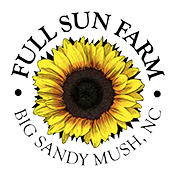It’s quite a box this week! Enjoy it all! Here we are at the top of the seasonal mountain. Most everything looks good from up here. So far this season has been going very well. We have enjoyed great help from our interns, our CSA worker members, friends, family, and a few strangers who just wanted to help out. Thanks to you all,…but it’s not over yet!
Among all the highlights of the Spring and Summer there has been some real problems. Our mountains are a wonderful place to live, as we all know. However, there are many, many different kinds of molds and fungus that also enjoy this climate. We’ve seen two new very damaging diseases appear on the farm this year. Southern blight was the first to show itself on our eggplant. This is basically an incurable, untreatable disease that could present some serious challenges to us for years to come. It can attack almost everything we grow and is very similar to our beloved phytothphera, except southern blight likes hot and dry and phytothphera likes it wet and cool. It is another disease that also really goes for the peppers and it’s there that it is causing the most damage. We have two varieties, that make up about 1/2 row, that are still looking good. They are loaded with green peppers now. We will see what they produce in terms of red. An advantage that we have in dealing with these diseases is that we farm organically. Our soils are full of life, all kinds of beneficial bacteria and funguses and molds so there is a lots of competition for the destructive ones. On a conventional farm, where they fumigate the soil at the beginning of the season and mono crop year after year the soil ecosystem is not so complex and a disease like southern blight spreads very quickly. The other mold came in on the basil seeds. Apparently European farmers have been dealing with this mold for about ten years, but lucky us, it came over the ocean this year. It seems to grow only on the sweet basil, not on the lemon or cinammon basil that we grow as a cut flower. Well, the mold has done a number on two rounds of basil. We have one more try, but there doesn’t seem to be much hope for the last sowing either. We’re working on finding a way to grow sweet basil. Hopefully, we’ll figure it out soon, but for now, no basil.
So that was a little depressing, but that’s the beauty of being a diversified farm. We grow many, many different crops so if one or two don’t make it, we still can. There are many other farmers at the markets and some may not be having the same problems we’re having this year, so support them by buying all the basil you need.
Nick’s Corner
Weekends on the farm are typically pretty laid back. With no work on the farm except going to market, we get to sleep late, do laundry,and maybe make a grocery run (for whatever things we don’t grow or make here at the farm) and enjoy “going to town.” This weekend, however, going to town was not an option. With Belle Chere occupying all of downtown and one of my favorite grocery store being within the defined radius of “downtown,” I forwent my weekend town trip for some time in front of the stove. Maggie and I had been wanting to make some jam for sometime. We’d talked about different fruit combinations and so on. This weekend our plan came to fruition. For four hours on Sunday we made peach jam, blueberry jam and a little experiment of blueberry-peach jam. We ended up with something around 22 half pint jars of jam…enough for a small army, or three hungry interns. Canning food is our way of preserving what delicious food we have access to now in the height of the season, for times when the food selection is slim. I always catch myself craving summer crops in the bitterest of winter time. So now is the time to think ahead and get a jump on continuing to eat local and organic so you can satisfy those midwinter cravings after the season is said and done.
I found myself the other day looking through seed catalogues. I have discovered that seed catalogues are quite the gardening/farming resource. Even after the initial ordering of seeds is done in the spring and mid summer, there is a plethora of information just waiting to be absorbed. Many times I find it easier to go to a seed catalogue and find the answer to a question than to consult a Rodale’s resource of some kind. With all of the pictures of perfect plants, fruit, veggies and flowers it’s great to just see what’s out there to be grown.
